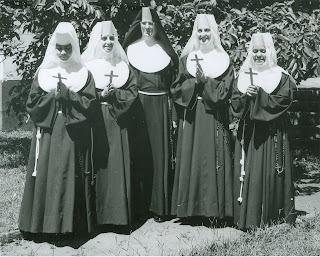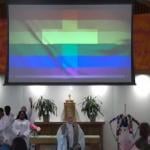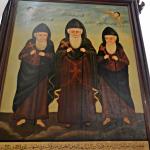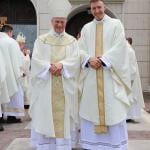Today marks the 150th anniversary of the founding of the Franciscan Sisters of Allegany. The following history is taken from the community’s website:
The Franciscan Sisters of Allegany, New York, trace their beginnings to April 25, 1859, when, in the chapel of St. Bonaventure College and Seminary, Father Pamfilo da Magliano, O.F.M., gave the habit of the Third Order of St. Francis and the name, Sister Mary Joseph, to Mary Jane Todd. Father Pamfilo (below, far right), the custos-Provincial of the Friars Minor of the Immaculate Conception Custody, had come with three other friars to western New York in 1855 at the invitation of Bishop John Timon, C.M., (below, right) of the Diocese. of Buffalo and Nicholas Devereux, a Catholic layman and land owner. The friars had come to educate young men at St. Bonaventure College (now St. Bonaventure University) and carry on pastoral work in the area. Bishop Timon had also asked Father Pamfilo to “seek for Sisters of the Third Order” to provide education for the young women of the area, and his search led him to form a new congregation in Allegany, New York.
After the reception of Sister Mary Joseph, Ellen Fallon was received on June 24, 1859, and took the name, Sister Mary Bridget. Several months later, these two Sisters were joined by Mary Anne O’Neil, a fifteen-year old girl from New Jersey who had been exhorted by Father Pamfilo to be generous with the Lord despite her young years. Mary Anne was received on December 8, 1859, and took the name, Sister Mary Teresa.
These three women formed the nucleus of the new community which soon began to attract other young women from the surrounding areas. From the beginning of the Congregation, the Sisters were under the jurisdiction of Father Pamfilo. He appointed the officers of the new community until 1865, when he presented the Sisters with their first statutes which had been adapted from those of the Franciscan Sisters in Glasgow, Scotland. That same year the Sisters held their first Chapter and elected Sister Mary Teresa O’Neil (pictured above) as their General Superior who served in this capacity for fifty-five years (two by appointment, 53 by election). It was Sister Mary Teresa O’Neil who was to give the leadership and formative vision to the new community and whose spirit and influence were to continue to the present time.
The new community grew and the Sisters sought to serve the needs of the Church in a variety of ministries. In 1860, St. Elizabeth Academy was opened in Allegany for the education of young women, and from this beginning the Sisters branched out to open schools in Connecticut, New York and other states along the eastern coast of the United States. In 1879, three Sisters were sent to Jamaica, British West Indies, and the FSA became the first American-founded congregation of religious women to send Sisters to the foreign missions. Missions were opened in Brazil in 1946 and in Bolivia in 1965. Sisters also went to serve the poor in the southern United States.
The year, 1883, marked the beginning of involvement with apostolates other than schools. The original purpose of teaching children expanded to include hospital administration and health care, homes for young and elderly, pastoral and social work and many more ministries, which continue, some, in different forms, to this day.
In 1959, a vision was fulfilled in the foundation of the Cloister. Eight years later the Council approved the concept of a Ritiro rather than a Cloister. This would allow for temporary members to join the permanent nucleus of Sisters. It was a significant step in the understanding and living out of the Franciscan journey. The Franciscan Sisters of Allegany, by deep, personal, receptive prayer, respond to the needs of the church, by love and full joy in Christ’s Gospel values; by having acceptance, compassion, hospitality and reverence toward all. The Sisters try to reflect the spirit of St. Francis of Assisi, that the Church may be an integral part of the life of each person they meet and serve.












